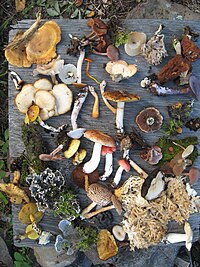
Photo from wikipedia
In terrestrial plants, it is well known that genetic diversity can affect responses to abiotic and biotic stress and have important consequences on farming. However, very little is known about… Click to show full abstract
In terrestrial plants, it is well known that genetic diversity can affect responses to abiotic and biotic stress and have important consequences on farming. However, very little is known about the interactive effects of genetic and environmental factors on seaweed crops. We conducted a field experiment on Gracilaria chilensis to determine the effect of heterozygosity and nutrient addition on two southern Chilean farms: Ancud and Chaica. In addition to growth rate and productivity, we measured photosynthetic responses, photosynthetic pigment concentration (chlorophyll a and phycobiliproteins), C:N ratio (C:N), and epiphytic load. Nutrient addition affected the growth rate, productivity, phycobilin, and C:N content, but not the epiphytic load. These results were independent of the heterozygosity of the strains used in the experiments. Interestingly, depending on the sampled sites, distinct photosynthetic responses (i.e., maximal quantum yield, Fv/Fm, and maximal electron transport rate, ETRmax) to nutrient addition were observed. We propose that thallus selection over the past few decades may have led to ecological differentiation between G. chilensis from Chaica and Ancud. The lack of effect of heterozygosity on growth and physiological responses could be related to the species domestication history in which there is a limited range of genetic variation in farms. We suggest that the existing levels of heterozygosity among our thalli is not sufficient to detect any significant effect of genetic diversity on growth or productivity in Metri bay, our experimental site located close to the city of Puerto Montt, during summer under nitrogen limiting conditions.
Journal Title: Journal of Phycology
Year Published: 2018
Link to full text (if available)
Share on Social Media: Sign Up to like & get
recommendations!